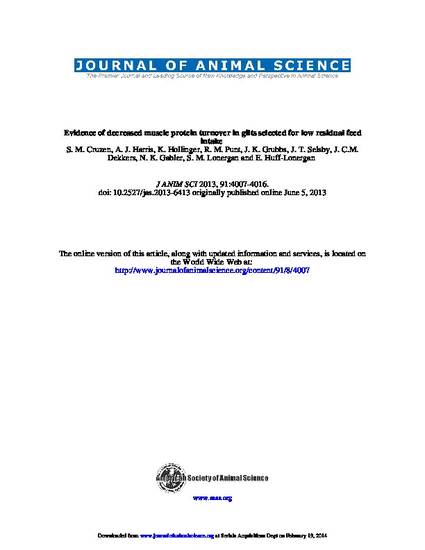
The objective of this study was to evaluate the contribution of muscle protein turnover (synthesis and degradation) to the biological basis for genetic differences in finisher pigs selected for residual feed intake (RFI). Residual feed intake is defined as the difference between expected feed intake (based on the achieved rate of BW gain and backfat depth of individual pigs) and the observed feed intake of the individual pig. We hypothesized that protein turnover would be reduced in pigs selected for low RFI. Twelve gilts from a line selected for 7 generations for low RFI and 12 from a contemporary line selected for 2 generations for high RFI were paired by age and BW and fed a standard corn–soybean diet for 6 wk. Pigs were euthanized, muscle and liver samples were collected, and insulin signaling, protein synthesis, and protein degradation proteins were analyzed for expression and activities. Muscle from low RFI pigs tended to have less μ- and m-calpain activities (P = 0.10 and 0.09, respectively) and had significantly greater calpastatin activity and a decreased μ-calpain:calpastatin activity ratio (P < 0.05). Muscle from low RFI pigs had less 20S proteasome activity compared with their high RFI counterparts (P< 0.05). No differences in insulin signaling intermediates and translation initiation signaling proteins [mammalian target of rapamycin (mTOR) pathway] were observed (P > 0.05). Postmortem proteolysis was determined in the LM from the eighth generation of the low RFI pigs versus their high RFI counterparts (n = 9 per line). Autolysis of μ-calpain was decreased in the low RFI pigs and less troponin-T degradation product was observed at 3 d postmortem (P < 0.05), indicating slowed postmortem proteolysis during aging in the low RFI pigs. These data provide significant evidence that less protein degradation occurs in pigs selected for reduced RFI, and this may account for a significant portion of the increased efficiency observed in these animals.
Available at: http://works.bepress.com/elisabeth_huff-lonergan/58/

This article is from Journal of Animal Science 91 (2013): 4007–4016, doi:10.2527/jas.2013-6413.